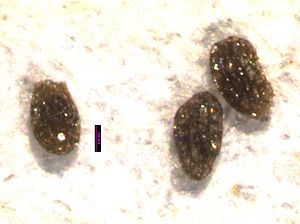Difference between revisions of "Aphyllon purpureum"
| Line 5: | Line 5: | ||
Synonyms: | Synonyms: | ||
| − | '' | + | *''Aphyllon uniflorum'' |
| − | *Orobanche uniflora var. typica | + | *''Orobanche uniflora var. typica'' |
| − | *Orobanche uniflora var. terrae-novae | + | *''Orobanche uniflora var. terrae-novae'' |
| − | *Orobanche uniflora var. sedii | + | *''Orobanche uniflora var. sedii'' |
| − | *Orobanche uniflora var. purpurea | + | *''Orobanche uniflora var. purpurea'' |
| − | *Orobanche uniflora var. occidentalis | + | *''Orobanche uniflora var. occidentalis'' |
| − | *Orobanche terrae-novae | + | *''Orobanche terrae-novae'' |
| − | *Orobanche sedii, Orobanche purpurea | + | *''Orobanche sedii, Orobanche purpurea'' |
| − | *Orobanche porphyrantha | + | *''Orobanche porphyrantha'' |
| − | *Thalesia uniflora | + | *''Thalesia uniflora'' |
| − | *Orobanche uniflora var. minuta | + | *''Orobanche uniflora var. minuta'' |
| − | *Orobanche uniflora ssp. occidentalis | + | *''Orobanche uniflora ssp. occidentalis'' |
| − | *Orobanche uniflora var. sedi'' | + | *''Orobanche uniflora var. sedi'' |
Revision as of 13:00, 7 May 2012
Orobanche uniflora is a flowering plant in the Orobanchaceae family. Also called naked broomrape, one flowered broomrape, or cancer root, O. uniflora is a parasitic plant.
Synonyms:
- Aphyllon uniflorum
- Orobanche uniflora var. typica
- Orobanche uniflora var. terrae-novae
- Orobanche uniflora var. sedii
- Orobanche uniflora var. purpurea
- Orobanche uniflora var. occidentalis
- Orobanche terrae-novae
- Orobanche sedii, Orobanche purpurea
- Orobanche porphyrantha
- Thalesia uniflora
- Orobanche uniflora var. minuta
- Orobanche uniflora ssp. occidentalis
- Orobanche uniflora var. sedi
Contents
Taxonomy
- Kingdom Plantae – Plants
- Subkingdom -Tracheobionta – Vascular plants
- Superdivision - Spermatophyta – Seed plants
- Division - Magnoliophyta – Flowering plants
- Class - Magnoliopsida – Dicotyledons
- Subclass - Asteridae
- Order - Scrophulariales
- Family - Orobanchaceae – Broom-rape family
- Genus - Orobanche – broomrape
- Species - O. uniflora
Description
General: Fleshy root parasites, the stems short, 1-5 cm. long, much shorter than the 1-3 pedicles, which are 3-10 cm. long; plants strongly glandular-villous. Leaves: Leaves none; flowers without bractlets. Flowers: Flowers 1-3 on elongate pedicles; calyx 4-12 mm. long, the 5 narrow, sub-equal lobes longer than the tube; corolla brownish-yellow to violet, 2-lipped, 15-35 mm. long, the 5 lobes finely fringed; anthers glabrous or hairy. Fruit: Capsule 2-celled
-from cnlm pages
Bloom Period
April to August
Distribution
Occurring on both sides of the Cascades in Washington; ranging throughout much of North America.
from cnlm pages
Habitat
Mostly in open, moist or dry places, from open woods, prairies, balds, and grasslands in the lowlands to moderate elevations in the mountains. Orobanche uniflora tolerates moist to dry soils, and is shade tolerant.
Uses
The whole plant is edible raw or cooked, and medicinally, Orobanche uniflora is laxative and sedative
-From cnlm pages that cites pfaf.org
Propagation
Photo Gallery
http://biology.burke.washington.edu/herbarium/imagecollection.php
References
- ↑ http://www.calflora.org/cgi-bin/species_query.cgi?where-taxon=Orobanche+uniflora
- ↑ ↑ USDA, NRCS. 2012. The PLANTS Database (http://plants.usda.gov, 16 April 2012). National Plant Data Team, Greensboro, NC 27401-4901 USA.
- ↑ http://biology.burke.washington.edu/herbarium/imagecollection.php
The Seeds
Orobanche uniflora
Seed sample from 2011
Features
Average Measurement: 0.2 x 0.1 x 0.1
Measurement Range: L: 0.1 – 0.3, W: 0.1 – 0.2, D: 0.1 – 0.2
Latitudinal Cross Section: elliptical ![]()
Longitudinal Cross Section: elliptical ![]()
Shape: Seed very small, slightly narrower at hilum and opposite apex. Seed generally egg shaped, some specimens more slender than others.
Color: Most seeds brown, some tan.
Surface: Seed coat deeply honeycombed, and somewhat iridescent.
Basic Explanations and Assumptions:
The dimensions for the seeds are length x width x depth. The location of the hilum is used as the base of the seed, and the length is measured from hilum to the opposite apex. Where a style is present, the length is measured from the hilum to the bottom of the style. Width is measured at a right angle to the length at the widest part. Depth is measured at a right angle to the intersection of height and width lines.
Measurements included are the mean average for each measurement of ten separate seeds.
All measurements in millimeters unless otherwise noted.

